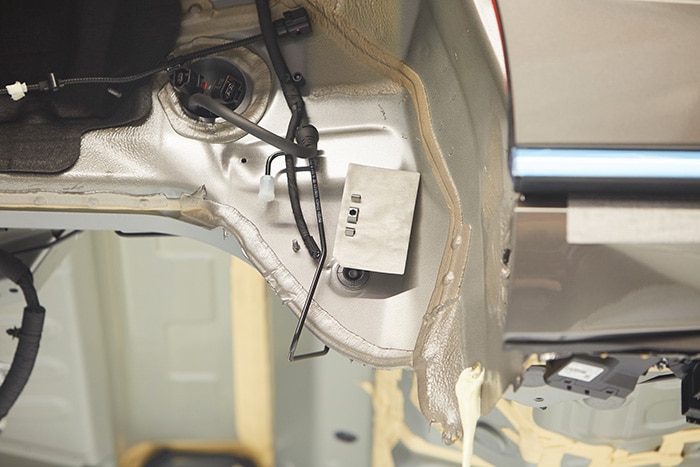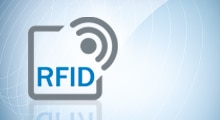It all starts with a piece of metal. In the body shop, the rear part of the vehicle represents the first stage in creating a customer’s specific order. Step by step, the car at long last starts to take shape. Once it has spent some time in the paint shop, this is the point at which even those without much interest in cars can see the individual notes that have been added – a fiery red, a deep black, or perhaps even a midnight blue. But even when it isn’t being given a striking paint job, the new Audi A8 can be manufactured in numerous customizable designs to make any customer’s wishes come true.
There is admittedly a long road to travel between the body shop and the new car’s first outing. Checks are required at many points along the way to ensure that the car is being produced exactly as the customer had intended upon ordering. In the German city of Neckarsulm, Audi is solving this task with the help of an RFID-based identification solution that covers all the types of tasks being carried out at its plant. On the production line of the successor model to the Audi A8, launched in 2017, UHF RFID read/write devices from SICK are hard at work. These devices reliably identify passive RFID labels on the vehicles at every step of the production process.

Production of the Audi A8 in Neckarsulm: Continuous wireless identification
“Whenever we design a new production line, we naturally think about the best ways of identifying workpieces at the individual stations”, says Jan-Erik Butt, who is responsible for RFID technology at Audi in Neckarsulm. “What we really want to achieve is an identification solution that takes in every area of the plant – from the body shop to the paint shop and all the way through to the final assembly area. The durability of RFID technology makes it ideally suited to this task. It also offers versatile connection options and can be flexibly integrated into the production system.”
To compare the performance of different suppliers, Audi conducted tests in its paint shop for a whole week. It is in this location that the RFID label on the vehicle is subjected to the highest levels of stress. “SICK was the clear winner when it came to reliability. We require 100 percent availability – in the automotive industry, not even 90 percent is good enough for us”, emphasizes Thomas Vogel, the specialist project manager in charge of digital manufacturing for the A8 model range.
Identification with maximum availability in challenging environments
During the production process, the vehicles are exposed to strong external influences such as extreme heat and chemicals. Circulating air temperatures in the paint shop reach up to 230 degrees, and in the case of cathodic dip painting, the vehicle is entirely immersed in a tank containing an acid/base mixture. It is at this stage in the process that a voltage is applied and the metal is coated with anti-corrosion treatment, explains Jan-Erik Butt.
The solution that the plant was looking for needed to stand up to these harsh conditions. As a result, the project team opted for single-use passive RFID labels. These can withstand extreme stress and are easy to mount on the car body, then remove during final assembly. “The start of car body production marks the point at which a main chassis beam is inscribed and customized. It is also at this point that it receives its order number and we affix the RFID label. This is the first time that variation comes into play, and we use this for identification purposes. From then on, we always have RFID features on the vehicle.” The RFID label is about the same size as a business card and is made from Nomex material, which protects the antenna inside and the chip against heat and other influences.

The changes that take place between one customized vehicle and another being built are usually found in the assembly process, and are dictated by the design that the customer has ordered. There is a very high level of variation at this stage and it is therefore essential that vehicles are correctly identified. Ultimately, each employee must know which vehicle they have in front of them in order to customize it as appropriate. As well as this, Audi has opted for a specific type of concept that makes it even more important for the RFID solution to perform reliably. The RFID reading process is linked to a belt stop, which means that the production line will come to a standstill if RFID identification of a vehicle fails at any given point. In this way, Audi can ensure that no vehicle leaves a station without having been identified. The RFID label is eventually removed during final assembly, amongst others on account of the sensitive production data it is associated with.
Standardized data overview for the entire process
For Jan-Erik Butt, another reason for relying on RFID is the consistently high standard of data quality delivered by the readings at every station. “If we acquire the same type of data from every area, we can generate informative trend analyses, for example. This is because the reading situations can be compared with one another. As a result, we are able to obtain extensive information on the entire production process – something that just wouldn’t be achievable if we were using a mixed bag of technology. And that naturally gives us the opportunity to take an entirely different approach – to put preventive measures in place rather than simply responding to situations all the time. For example, we are working on methods of observing how reading quality gradually deteriorates and intervening before problems occur.”
The perfect function for specific applications
As part of its RFID solution, the Audi site in Neckarsulm is using the SICK AppSpace eco-system, which allows tailor-made sensor apps to be programmed with ease. “We want to harness new ways of processing data further, exactly in line with our needs. For example, we are implementing SICK AppSpace at reading points in order to allow the antenna to communicate directly with the MES system that we use to control production, and to do so in the appropriate format for the recipient. Without the need for any additional middleware, we are able to create a service-based architectural framework, such as OPC UA, that is not reliant on any particular platform or manufacturer. This means that we don’t have to change all the system settings each time reprogramming takes place. Instead, we can use an app to remotely determine how the antenna is to process and transfer data. We want the ability to operate a whole range of different functions flexibly within a single reading device. It therefore makes sense to use an antenna that is more intelligent too.”

RFID as an overarching identification strategy
Summing up, Jan-Erik Butt has a positive view of how things have progressed: “If we compare the situation before and after, we can see that the successful switch to the new technology has led to an increase in availability and even significant time savings in many cases. In contrast to the original proprietary systems, commissioning RFID antennas is less time-consuming.”
What started as part of a vehicle project, and was designed for a specific product derived from another product, has now been up and running throughout the plant for some time now: “The results we have gained from the RFID identification process have won us over. Instead of RFID only being used in a single hall or as part of a single vehicle project, the Neckarsulm site is using it for identification purposes at every stage of production.”
Related Posts:
Digitally supported production with interoperable sensor communication
Paper per running meter: RFID technology ensures an accurate production sequence
Identification solutions for picking potted plants
Programmable sensor solutions with SICK AppSpace



